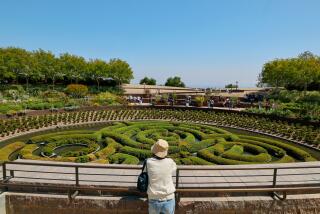Banner Days of Haitian Folk Art : Voodoo Flags Reflect Religious Joy and Cultural Heritage in Brilliant Colors and Ornaments
- Share via
FULLERTON — At the moment, the image many Americans have of Haitian culture is that of a terrified people fleeing their impoverished, politically volatile homeland aboard rickety boats.
A vastly different vision is on view in a new exhibition at Fullerton Museum Center. This one celebrates the country’s vital religious life and cultural diversity in dazzling colors and glittering light.
“Haiti: Symbols de Mystere” features voodoo flags: icon-like cloth banners depicting sacred images made of kaleidoscopically colored sequins, glass beads and pearls.
“Amid all the hardship, Haitians are able to create something this magnificent and inspiring and beautiful,” curator Martha Henry said. “It reflects the kind of joy these people have in their lives.”
Opening today, the display actually comprises two shows. “Haitian Voodoo Flags,” a traveling exhibit Henry curated for Connecticut’s New England Center for Contemporary Art, contains about 40 flags, Haiti’s oldest art form.
“Haitian Religious Folk Art” has fewer flags and more sacred objects, including fetishes and drums, courtesy of Los Angeles collector Virgil Young.
Not mere hocus-pocus involving pin-stuck dolls, Haitian voodoo is a complex religion that permeates every aspect of Haitian life.
Rooted in tribal beliefs of West Africa, it was brought to the country in the 16th Century by African slaves. Those beliefs were subsequently influenced by Catholicism practiced by the French, who exerted power in Haiti until it became independent in 1804.
Voodoo involves a vast, evolving pantheon of male and female god-spirits, or loa . They may be benevolent or cruel, and they grant health, protection and prosperity.
Their images are often represented on the brilliant flags, which are intended to please the deities and are used in elaborate ceremonies that may last for weeks.
Haitians do not follow Catholic doctrine, but they allow Catholic saints to personify loa who have similar attributes. For instance, St. Jacques (also known as St. James), clad in military regalia and on horseback, represents Ogoun Feraille, the war loa .
Flags bearing Ogoun Feraille’s image are typically paired with those depicting Damballah, the supreme male spirit, or fertility loa , who is symbolized by snakes, Young said. An advertising stylist, Young has traveled to Haiti repeatedly over the past decade collecting Haitian sacred art.
“More often than not, the voodoo temple will have two flags, usually one for St. Jacques and one for Damballah,” he said. “They may have a third flag of Bossou (a demonic, bull-headed god) or Agoue, god of the waters, who protects sailors and fishermen.”
The flags, which have been made since the start of the century, also bear abstract veve (West African symbols) and are related to African tribal beadwork traditions. Sequins, probably first adapted from the French, have long been used in their creation, Henry said.
“They reflect light, and light has great significance in the religion,” she said.
The flags became more elaborate some 30 years ago when Haitian painting underwent a renaissance, Henry said. Most flags in the exhibit date from this period.
“There was this flowering of artistic creativity in Haiti,” Henry said. “Tourists loved the paintings and began to buy them. Some now sell for up to $60,000. So the flag makers began to create flags far more ornate and complex compositionally to compete.”
While not ignoring religious and cultural aspects of the flags and objects, the exhibit emphasizes their aesthetic qualities, which most interest Henry and Young.
“Da Vinci and Michelangelo produced art for the church,” Henry said. “Their work stands out as art, regardless of the religious affiliation. I’d like to show these flags as an art form, as pieces of contemporary art.”
Added Young: “In poor countries, religion is often the only vehicle an artist can find for his or her work. . . . If it’s done for the gods, it’s legitimate.”
Flag makers are commonly voodoo priests or priestesses, such as Clotaire Bazile, Sylva Joseph and Corl Sonndaguzon, all showcased in the exhibit. Each has a distinct style, Henry said, whether lyrical, abstract or aggressive.
Antoine, represented by several works, is not a priest but a “superb” flag maker, Henry said. She said Antoine’s complex compositional devices--intricate patterning, unusual color combinations and layers of iconography--are comparable to those found in much contemporary painting.
“He shows where these flags can go as an art form,” she said.
Fullerton Museum Center officials included Young’s three-dimensional objects--lushly beaded bottles, whimsical fetishes, large drums and French iron crosses--to expand the exhibit visually.
Although recent unrest has prevented him from visiting the country much lately, over the years Young has amassed more than 250 pieces, including some flags dating to the 1930s and ‘40s.
How did he get them?
By “just going to places and meeting Haitians and letting them know what I wanted,” he said.
“I found that Haitians wanted the same things in life that people in Judeo-Christian society want: a healthy body, mind and spirit,” Young said.
“They take great pride in their places of worship and in themselves,” he said, “and it excited them that this person from another culture was interested in them.”
“Haiti: Symbols de Mystere,” presented for Black History Month, runs today through March 28 at Fullerton Museum Center, 301 N. Pomona Ave. Hours are Wednesday, Saturday and Sunday, noon to 4 p.m.; Thursday and Friday, noon to 9 p.m. $2, adults; $1, students and senior citizens. (714) 738-6545.
More to Read
The biggest entertainment stories
Get our big stories about Hollywood, film, television, music, arts, culture and more right in your inbox as soon as they publish.
You may occasionally receive promotional content from the Los Angeles Times.










